Physical Address
304 North Cardinal St.
Dorchester Center, MA 02124
The spinal column consists of multiple segmented osseous vertebrae, the intervertebral discs interposed between these segments, and the ligaments and joints that bind the segments together. The spine has 32 to 35 vertebral segments, traditionally considered as 7 cervical, 12 thoracic, 5 lumbar, 5 sacral, and 3 to 5 coccygeal segments. The relative lengths of the cervical, thoracic, lumbar, and sacral spines are in proportion as 2: 5: 3: 2.
The vertebrae articulate with each other by a com-bination of cartilaginous, synovial, and fibrous joints. The cervical spine articulates with the skull base at the craniovertebral junction and with the thoracic spine at the cervicothoracic junction. The thoracic spine articulates with the heads of the ribs at the costocapitular (costovertebral) joints, with the necks of the ribs at the costotubercular (costotransverse) joints, and with the lumbar spine at the thoracolumbar junction. The sacrum articulates with the lumbar spine at the lumbosacral junction, with the ilia at the sacroiliac joints, and with the coccyx at the sacrococcygeal junction.
The anterior surface of the spine merges into the lateral surface with no clear demarcation. The lateral surface is demarcated from the posterior surface by the articular processes in the cervical region, by the transverse processes in the thoracic region, and by the articular processes again in the lumbar region. The posterior surface is the posterior face between the articular and transverse processes of each side.
The spinal column measures approximately 70 cm in males and 60 cm in females. Approximately 80% of that length is due to bone and 20% to the intervertebral discs. Diurnal variation in disc hydration changes the length of the spinal column approximately 16 mm over the day. The loss of height is greatest in the first 3 hours after awakening and in adolescents and young adults.
The spine normally displays specific dorsoventral curvatures ( Figs. 3-1 and 3-2 ). Posteriorly directed concavity is designated lordosis . Posteriorly directed convexity is designated kyphosis . The normal cervical lordosis extends from C2 to T2, with the apex at C4-C5. The normal thoracic kyphosis extends from T2 to T11 or T12, with the apex at T6 to T9. The normal lumbar lordosis extends from T12 to the lumbosacral junction with the apex at L3. As a result of these curvatures, a plumb line suspended from the external auditory canal of a standing adult would pass through the dens of C2, just anterior to the vertebral body of T2, through the center of the vertebral body of T12, and through the posterior portion of the vertebral body of L5, coming to hang anterior to the sacrum. Muscle changes associated with handedness may induce slight asymmetric lateral curvatures of the upper thoracic spine to the right in right-handed persons and to the left in left-handed persons.
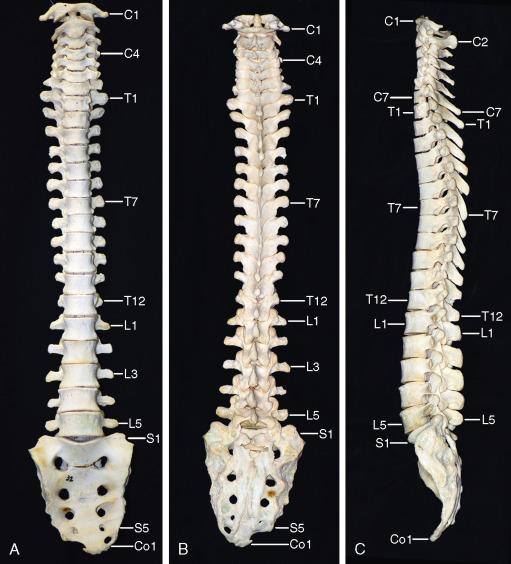
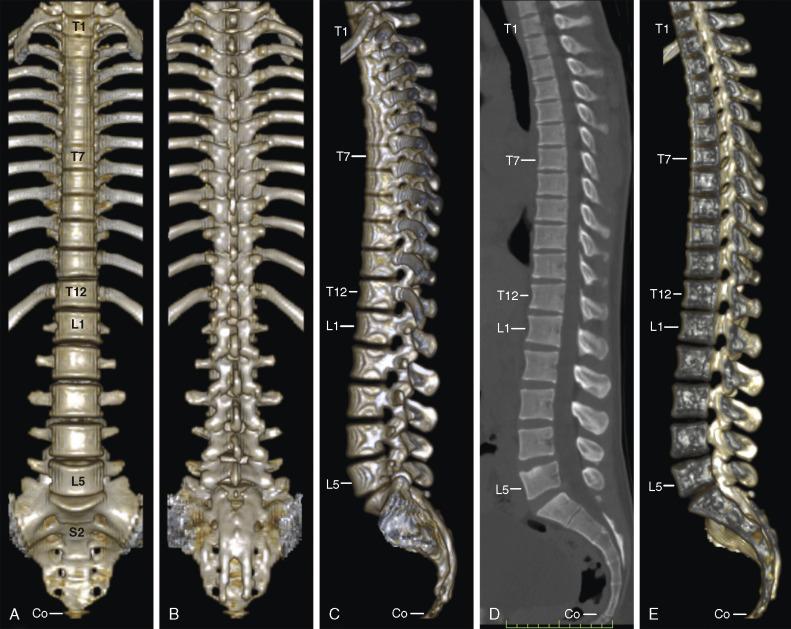
Each osseous vertebra has a standard overall structure, composed of an anterior vertebral body and a posterior neural arch ( Figs. 3-3 and 3-4 ). This general shape is modified secondarily at each level. Each vertebra has an outer shell of dense cortical bone and an inner core of less dense, cancellous bone. The cortical bone is thick over the neural arch, less thick along the sides of the vertebral body, and thinnest where the upper and lower surfaces of the vertebral body abut the disc. The cancellous bone contains the vertebral marrow.
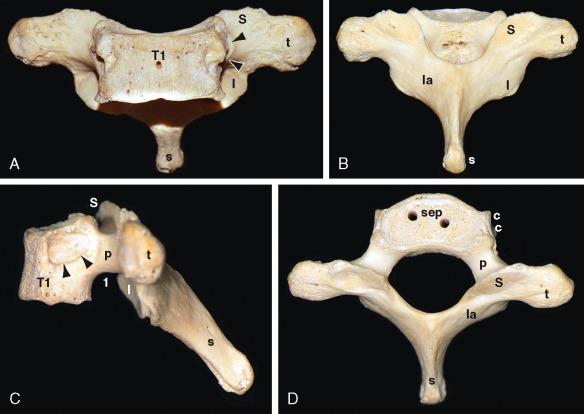
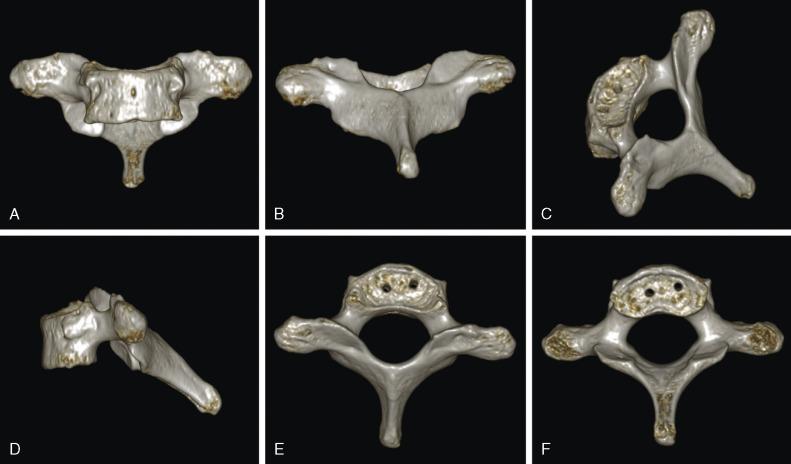
The vertebral body forms the front of each vertebra, anterior to the spinal canal. The body is shaped like an asymmetric cylinder with concave side walls. The top and bottom of each body resembles a drum head, with a smooth, raised periphery and a roughened flat-to-scaphoid center.
The neural arch forms the lateral and posterior portions of each vertebra, lateral to and behind the spinal canal. Each neural arch is composed of paired pedicles, paired laminae, paired articular processes, and a single, posteriorly directed spinous process. The pedicles form the two sides of the spinal canal. These narrow struts arise from the upper posterolateral surface of each vertebral body and pass posteriorly to merge into the laminae. The pedicles are roughly cylindrical in coronal section. In lateral view, they show shallow curves on their upper and lower borders (the gentler superior vertebral notch and the deeper inferior vertebral notch). The laminae are flattened, obliquely oriented plates of bone that form the posterior/posterolateral walls of the spinal canal. They merge with the pedicles anteriorly and angle toward each other posteriorly to fuse with the base of the spinous process in the midline. The spinous process arises from the medial edges of the paired laminae and juts posteriorly and inferiorly in the midline behind the spinal canal.
The superior and inferior articular processes lie posterolateral to the spinal canal. They arise where the pedicles merge into the laminae. From there, the paired articular processes project superiorly and inferiorly to form synovial articulations with the articular processes of the next-higher and next-lower vertebrae ( Fig. 3-5 ). At each articulation, the superior articular processes of the lower vertebra lie anterior to the inferior articular processes of the upper vertebra. The facets of the superior articular processes face posteriorly to fit with the anteriorly facing facets of the inferior articular processes.
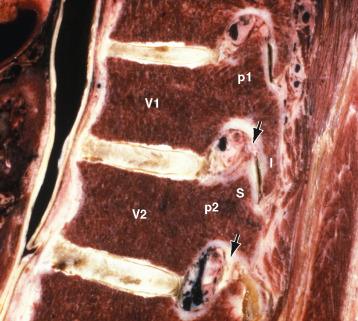
The transverse processes of the vertebrae also arise where the pedicles merge into the laminae but project laterally. In the thoracic region, these processes are true transverse processes (designated diapophyses ) that articulate with the ribs (designated pleurapophyses, costal elements ). At other spinal levels the similar, laterally projecting bony elements are composed of both true transverse processes (diapophyses) and incorporated pleurapophyses (costal elements).
The neural foramina are the soft tissue and osseous channels between vertebrae that convey the spinal nerves and blood vessels into and out of the spinal canal ( Figs. 3-5 and 3-6 ). Superiorly and inferiorly the neural foramina are bordered by the periosteum of the concave margins of the pedicles. The superior border of the neural foramen is the undersurface of the upper pedicle. Therefore, the deeply curved inferior vertebral notch of the upper pedicle constitutes the roof of the neural foramen. The inferior border of the neural foramen is the upper surface of the lower pedicle. Therefore, the shallower superior vertebral notch of the lower pedicle constitutes the floor of the neural foramen. On their anterior wall, from above downward, the neural foramina are bordered by the periosteum of the posterior surfaces of the upper vertebra, the syndesmosis formed by the hyaline cartilage end plates and disc, and the periosteum of the posterior surface of the lower vertebra. Posteriorly, the neural foramen is formed by the periosteum over the pars interarticularis, the ligamentum flavum, and the synovial capsule of the facet joint. At T1 to T10 only, the anterior border of the foramen also includes the synovial capsules for the articulations of the ribs.
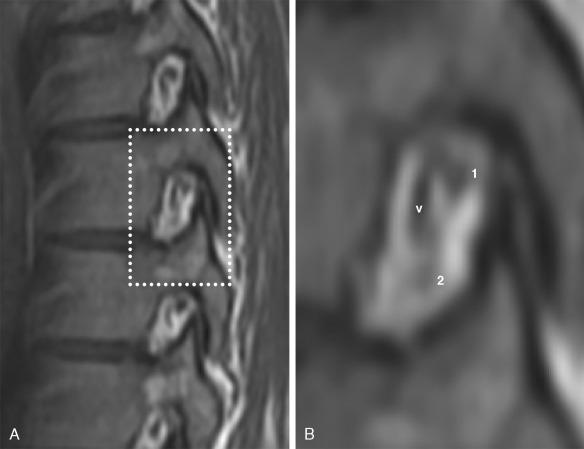
The marrow within the vertebra consists of both red hematopoietic marrow and yellow fatty marrow ( Figs. 3-7 and 3-8 ). Additional small (2-4 mm) intraosseous nodules of notochordal remnants are found in 14% of spinal columns. From birth to approximately age 2 years, the vertebral marrow is predominantly red hematopoietic marrow. It converts progressively, diffusely and homogeneously to yellow fatty marrow with growth and development. From early middle age onward, the conversion of red to yellow marrow progresses more slowly and inhomogeneously. The fat fraction of the lumbar vertebral marrow is usually higher in men than women and may increase from 27% to 70%, at a rate of approximately 7.5% per decade in adulthood. In the adult, the fat content of the lumbar marrow usually increases from L1 to L5. However, the distribution of the fat is variable and heterogeneous. The red marrow may cluster near the anterior margin of the vertebral body and at the end plates. Because fat and hematopoietic cells both grow by expansion of cell clusters to form nodules, fatty conversion tends to create islands of juxtaposed red and yellow marrow. The increase in the fat fraction with age correlates with the atherosclerotic decline in overall vascular perfusion and with reduced bone mineral density.
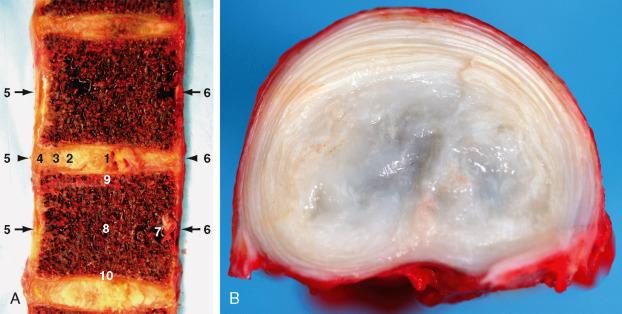
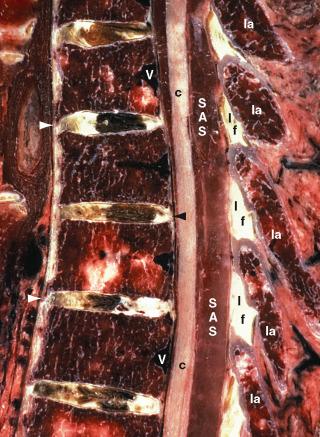
The heights of the vertebral bodies generally increase from the cervical to the lumbar spine. Within the thoracic spine, the T3 body is smallest. Below this, the thoracic and lumbar vertebral bodies increase in size progressively down to L4, with a slight decrease in height at L5. The width (transverse dimension) of the vertebral bodies increases progressively from C2 to L3, with variable width of L4 and L5. The width of the vertebral bodies then decreases from S1 to the lowest coccygeal vertebra.
The vertebral canal is large and triangular in the cervical region, small and circular in the thoracic region, and again large and triangular in the lumbar region. The lumbar canal diminishes progressively from L1 to L5. The shortest transverse distance between the most medial curvatures of the paired pedicles is the interpediculate distance. This varies systematically along the length of the spinal canal, giving a characteristic pattern that is most commonly displayed as a graph (see ).
The medial borders of the pedicles are typically convex toward the spinal canal. In the region T11 to L2, however, the medial aspects of the pedicles may be flattened or even concave as a normal variation. As a result, the interpediculate distance may normally be increased at these levels.
C1 has a posterior arch but no laminae. The C2 and C7 laminae are very thick and robust. From C3 to C6 the cervical laminae are thin and wide with narrow craniocaudal extent. The thoracic laminae are generally thicker, wider, and taller than the cervical laminae but vary along the length of the thorax. The T1 laminae are very broad. The laminae narrow from T2 to T7, broaden again from T8 to T11, and narrow again from T11 to L3. The lumbar laminae are more robust than the cervical or thoracic laminae (except C2 and C7), are narrower than most thoracic laminae, and are intermediate in their craniocaudal length.
The articular surfaces and synovial facet joints are relatively flat in the cervical and thoracic spines but more complex and cup shaped in the lumbar spine. The cervical facet joints are oriented in an oblique coronal plane at an angle of 30 to 50 degrees to the vertical (measuring the narrow angle from the superior facet surface to the inferior vertical). The thoracic facet joints down to about T10-T11 are oriented in a steeper oblique coronal plane, making a narrower angle of 15 to 20 degrees to the inferior vertical. From about T11-T12 to about L2-L3, the facet joints transition into a more nearly sagittal orientation. Below this, the posteroinferolateral portions of the cup-shaped facet joints are oriented in the sagittal plane whereas the anterosuperomedial portions of the same facet joints are oriented in the coronal plane.
By shape, cervical transverse processes are long and broad at C2, narrower and more delicate at C3-C6, and longer again at C7. Thoracic transverse processes are broad at T1 and decrease in breadth progressively from T1 to T12. The T12 transverse processes are nearly absent. Lumbar transverse processes become broader from L1 to L3 and usually increase at L4 and L5, so that the L5 transverse process is sturdiest and arises directly from the body and pedicle to transfer weight to the pelvis. The angulations of the transverse processes and their positions relative to the pedicles, articular facets, and neural foramina vary with the spinal level. By position, cervical transverse processes lie anterior to the articular processes, lateral to the pedicles, and vertically between the two adjacent intervertebral foramina. Thoracic transverse processes lie posterior to the pedicles and neural foramina, farther back than the transverse processes of other portions of the spine. Lumbar transverse processes lie anterior to the articular processes but posterior to the intervertebral foramina.
The C1 spine is vestigial, forming only the posterior tubercle of C1. The C2 spine is large and strong, whereas the C3 spine is very short and thin. From C3 to C7 the spines gradually increase in length, so the longest cervical spine is C7. The spines are bifid at C2-C5, variably single or bifid at C6, and characteristically single and pointy at C7.
The T1 spine is robust and about as long as C7. From T2 to about T8 the thoracic spines are thin and long, angle far inferiorly, and overlap each other extensively. From T9 to T12 the spines shorten, thicken, and incline directly posteriorly.
From L1 to L3 the spines thicken, enlarge, and point directly posterior. The L4 spine is often slightly smaller than the L3 spine. The L5 spine is variable but usually smaller than the L4 spine.
The spines of S1 to S3 (or S4) fuse together into the median sacral crest with three to four spinous tubercles marking their remnants.
Together, the spinous processes, adjoining laminae, and transverse processes form paired paraspinal gutters for the dorsal paraspinal musculature. In the cervical and lumbar regions these gutters are shallow and are composed mainly of the laminae themselves. In the thoracic region, they are deeper and broader and are formed by both the laminae and transverse processes.
Become a Clinical Tree membership for Full access and enjoy Unlimited articles
If you are a member. Log in here